#Chloride contamination
Explore tagged Tumblr posts
Text

Chloride Remediation: Keeping Our Environment Safe and Saline-Free
Chloride remediation refers to the process of removing or reducing the concentration of chloride ions in soil, water, or other materials. Chloride ions are negatively charged particles that are commonly found in natural and man-made environments, and they can pose a variety of environmental and health hazards if they are present in high concentrations.
One of the most common sources of chloride ions is road salt, which is often used to de-ice roads and sidewalks during the winter months. As snow and ice melt, the salt dissolves and can enter nearby water sources, where it can harm aquatic life and contribute to the salinization of freshwater resources.
To remediate chloride contamination, a number of different strategies can be used, depending on the source and extent of the contamination. One common approach is to use specialized filtration systems that are designed to selectively remove chloride ions from water or other fluids. Other methods include chemical precipitation, ion exchange, and reverse osmosis.
Another important approach to chloride remediation is prevention. By reducing the use of road salt and other chloride-containing substances, it is possible to minimize the amount of chloride that enters the environment in the first place. This can involve using alternative de-icing agents, such as sand or calcium magnesium acetate, or implementing more environmentally-friendly road maintenance practices.
Overall, chloride remediation is an important aspect of environmental management, as it can help to protect both human health and natural ecosystems from the negative impacts of chloride contamination. By using a combination of remediation and prevention strategies, it is possible to minimize the amount of chloride that enters the environment and ensure that our natural resources remain healthy and sustainable for future generations.
#Chloride contamination#Environmental management#Water pollution#Road salt#Filtration systems#Prevention strategies#Ion exchange#Chemical precipitation#Reverse osmosis#Sustainable resource management
0 notes
Text
.
#yaknow I think if you post crap like:#*the chem spill is going to fatally contaminate the soil of the whole state for a century and kill every single pet and all the fish -#- and poison the watershed from the Ohio r. to the Mississippi r. to the Gulf*#and you don’t cite one damn source#you deserve every *source OP??* you get in your inbox#and no a twitter thread is not a source#additionally just an explanation of *this is what vinyl chloride does* is not enough of a source.#you need to be able to contextualize your claims with the chemical MSDS the concentration and the place/events#like *this much X will have Y effect in Z setting/treatment*#you're not Worry-Posting when you have like 50k followers and you're making Dire Absolute Pronouncements.#you need to think carefully about what you say and how you say it#quit fucking tagging your pithy comebacks to people concerned w ur science reporting and ethics as *modern day cassandra*#yes it’s worrisome beyond belief and yes I am worried the environmental health consequences for this will be more severe than we think#but no getting called out for lying is not the equivalent of being a modern day Cassandra
14 notes
·
View notes
Text
Writing Notes: Wound Care
Wound care - involves cleaning a wound, flushing or irrigating it with pressurized water or an antiseptic solution, and applying or changing a dressing.
Immediate Wound Care
Applying direct pressure to control any bleeding
Examining the wound for dirt and foreign objects after any bleeding has stopped
Cleaning the wound by gently flooding it with saline solution if available, with bottled water, or with clean running water
Gently cleansing the area around the wound with soap and clean water
Patting the area dry and covering it with an adhesive bandage or clean dry cloth
Leaving uncovered bites, punctures, and wounds that cannot be properly cleaned to prevent trapping bacteria that could result in infection

Aftercare
Aimed at preventing infection.
Puncture wounds or contaminated wounds may require a tetanus booster shot.
Dressings should never be reused.
Any soiled laundry from wound care procedures should be washed separately from other laundry, possibly with bleach.
Sometimes a wound-drainage culture is used to test for bacteria, fungi, or viruses in open wounds from punctures, cuts, tears, or surgical incisions or abscesses.
Abscesses require making a small incision in the skin to obtain pus or fluid from the wound.
The tip of a sterile cotton swab or a syringe and small needle (needle aspiration) is used to remove the sample for culturing.
Some Terminology
Aerobe—Bacteria that require oxygen to live.
Alginate—Colloidal substances from marine brown algae, especially giant kelp, that are used for wound dressings.
Anaerobe—Bacteria that live only where there is no oxygen.
Antiseptic—Chemicals applied to the skin to destroy bacteria and prevent infection.
Autolytic—Self-digestion; breakdown of tissue by the body’s own enzymes.
Debridement—The removal of cut, dead, or contaminated tissue.
Dehiscence—The opening of sutures from a surgical incision.
Dressing—The covering of a wound.
Exudate—Drainage from a wound; an exudative wound is one that drains fluid and pus.
Hydrocolloid—Dressing material that turns into a gel when combined with watery drainage.
Hydrogel—A water-based dressing material.
Hydrophilic—Dressing material that absorbs water.
Irrigation—Flushing or washing out a wound.
Necrotic—Dead tissue.
Normal flora—The mixture of bacteria normally found at specific body sites.
Normal saline—Physiological saline; a solution of 0.9% sodium chloride, the approximate salt concentrate of blood and tissues.
Tetanus—Lockjaw; a rare but often fatal infection caused by the bacterium Clostridium tetani that lives in soil, dust, and manure.
Source ⚜ More: Writing Notes & References More: Writing Realistic Injuries ⚜ On Anatomy ⚜ On Wounds
#writing notes#wound#writeblr#dark academia#spilled ink#literature#writers on tumblr#writing reference#poets on tumblr#writing prompt#poetry#creative writing#terminology#writing inspiration#writing ideas#thomas eakins#light academia#writing resources
256 notes
·
View notes
Text
basic ass witch tips 🔮
[revised post from ~2018 & last edited on 9.29.24]
please note that these are all related to things i have actually seen discussed or mentioned. please do your research before blindly following the advice of someone online, myself included.
if you're on some kind of medication, including but not limited to hormonal birth control, heart medication, and anti-depressants, double check with your healthcare professional/provider [HCP] before you drink that new tea you just bought.
always, always, always tell your HCP before trying any kind of herbal supplement, whether it’s something you made yourself or something you bought at the store.
have a diagnosed medical condition? talk to your HCP before ingesting anything or putting anything on your body that you aren’t familiar with.
don’t. drink. essential. oils. essential oils are not consumable!!!!!
citrus oils can cause photosensitivity, or being sensitive to light and more susceptible to sunburns so be mindful when using these oils on your skin.
if it hasn't been emphasized enough, PLEASE dilute your essential oils before use! common carrier oils are grapeseed, castor, olive, coconut, avocado, almond, etc.
oil and water don't mix, so you would need to use an alcohol based solution with essential oils to dilute them that way (if you plan to use them for a spray or something of that nature).
be mindful of using sprays, incense, powders, etc. that could release particulates into the air around pets or those who have allergies, respiratory issues, etc.
don't involve your pets in your practice in a way that could be harmful to them - no essential oils on them, no crystals in their water bowl, no moon water that's been sitting on your shelf for weeks.
i beg you, please don't put crystals in any uh bodily orifices.
there are some herbs you absolutely cannot burn (or use safely, really) for any reason, so make sure you're educated on all that beforehand; yew, for example, is highly toxic and potentially fatal if consumed or inhaled. the leaves, bark, and seeds contains a chemical called taxine, which is what some of the most hardcore chemotherapies are made from so keep that in the back of your mind.
that being said, please wear gloves and use common sense if you decide to forage for your own herbs or plants. i know that plant identifying apps exist so if you have a smartphone, that might be a good place to start.
putting salt on grass does a couple of things: salt removes moisture from the soil, thus drying out the grass and killing it; and, salt causes chloride to build up in the soil, thus making it toxic which inhibits chlorophyll production, leading the grass to eventually "starve" and die - please don't do this.
don't leave candles unattended - even small ones; it's not a good habit to get into.
also!! crystal balls in direct sunlight can cause a fire so be careful!
more fire stuff - be mindful of the environment and also safety so check for burn bans before you make a fire outdoors.
sterile lancets, not needles or pins. that's all i'm gonna say about that.
don't drink water you collected from anywhere outside unless you plan to properly filter it first.
if you plan to store water for later use (moon water, for example), refrigerate it or set it in a cool, dark place.
distilled water is free of minerals and contaminants so it has a longer shelf life than tap or bottled water - keep this in mind when making charged waters or other potion type things.
fresh herbs or other things of that nature left at room temperature can also grow super harmful bacteria. for example, putting raw garlic in olive oil and leaving it at room temperature will end as a breeding ground for botulism and mold.
be safe out there!
© 2024 𝚊𝚍-𝚌𝚊𝚎𝚕𝚎𝚜𝚝𝚒𝚊
212 notes
·
View notes
Text
"An estimated six million tonnes of used coffee grounds are created annually. Most go to landfill, generating methane and CO2, or are incinerated for energy.
It’s an obvious waste of a byproduct still rich in compounds (if not flavour). On a domestic level, try directing your cafetiere contents to your garden, not your bin: used coffee grounds are excellent as an addition to home compost bins and wormeries, a mulch for roses and a deterrent to snails. And on a global scale, science might have the answer.
A new study in the Journal of Chemical Technology and Biotechnology suggests that used coffee could hold the key to a pressing environmental problem: agricultural contamination.
How could old coffee grounds solve agricultural pollution?
Scientists from Brazil’s Federal Technological University of Paraná found that leftover coffee can absorb bentazone, a herbicide frequently used in agriculture.
When old coffee grounds are activated with zinc chloride, their carbon content becomes 70 per cent more efficient in removing the herbicide.
The study’s tests involved bentazone dissolved in liquid and treated with activated carbon from used coffee grounds, to see how it affected onion root tissues called meristems. All plants grow from meristem tissue and a plant’s development is disrupted when its meristems are damaged.
If the test can be replicated on an industrial scale, it would be an environmental double whammy: diverting coffee waste from landfill and preventing damage to wildlife and nature from herbicides.
Why is bentazone a problem?
...The UK’s Environment Agency cites bentazone as having the potential to affect long-term water quality and lead to an increased need to treat the UK’s drinking water sources. The herbicide has been shown to impact human health if it is inhaled, ingested or absorbed through the skin.
While this is only preliminary research and more studies are needed to determine efficacy of activated coffee grounds on a global scale, it’s a promising start. The authors of the study say their results “suggest a circular economy solution for spent coffee grounds that are currently discarded without any recycling or reuse system”. We can all drink to that."
-via EuroNews.green March 25/2024
#coffee#coffee grounds#circular economy#brazil#uk#united kingdom#pesticides#herbicides#environment#pollution#agriculture#good news#hope
293 notes
·
View notes
Text
Signal Boost

Horrible https://www.instagram.com/p/CokzHYprtJc/
#ohio#disaster#chrisis#vinyl chloride#explosion#contamination#destruction#calamity#east palestine#media blackout#reporters silenced
30 notes
·
View notes
Text
Seeing the difference in coverage (news media vs social media) on the Feb 3rd train derailment in East Palestine, Ohio, USA on and all the issues caused by the incident, I want to see something;
The incident summed up (and there may be even more I missed):
train carrying 150 cars, twenty of which contained hazardous materials, derailed due a failure of a wheel bearing, due to poor inspection because inspections were cut from 3 minutes per train to 90 secs per train. (Remember the railroad strike? Yeah. Part of what they wanted, in addition to better conditions, was more time to inspect trains and to get faulty parts fixed. They were refused, and now we're here.)
the derailment (of 50 cars) caused a fire which threatened to make a car(s) with the vinyl chloride explode, so a controlled release (burn) of the vinyl chloride (toxic, flammable gas) was done to prevent this
residents within a 1 mile radius were evacuated beforehand
the event resulted in contamination of the air/water and mass deaths of animals like fish and chickens
residents were told it's safe to return home a week after the evacuation, and found their pets dead; water smells wrong; air smells and/or burns their eyes
People miles away are having the same issues with animals dying (schools of dead fish in water, livestock sick/dying) and water contamination
The chemicals are contaminating the Ohio River Basin (which is more than just the Ohio River, and effects/includes KY, WV, TN, IN, OH, and parts of IL, PA, VA, and NC) and could potentially also lead to the whole Mississippi River Watershed being contaminated. (that's like, 40% of the continental United States and starts to touch into Canada.)
That all said,
Please reblog if you vote so we can get a larger sample size!
Many think the Railroad company (and the government, because they sided with the railroad company in ending the strike) are trying to cover this up in the news as much as possible, and that most coverage is coming from social media (specifically TikTok) and I want to see just how true that is.
I'm not not kidding when I say I have people IRL, who do keep up with the news, who never heard about the derailment at all until I told them just a couple days ago. It doesn't look good.
#ohio#ohio train derailment#east palestine#vinyl chloride#east palestine train derailment#east palestine ohio#norfolk southern#reblog to boost#poll#polls#news#tiktok#tumblr#twitter#news media#social media
294 notes
·
View notes
Text
Who ended up in the hospital more: Mulder or Scully?
The following calculations come from the hard work of @xfilesobsession, my idol
Note: this is solely a list of their on-screen hospital appearances where they were admitted as patients (in gowns), not all the times they were injured and/or briefly taken care of.
Beyond the Sea (1x13)
Patient: Fox Mulder
Reason: He was shot during a rescue mission.
Current Total Mulder: 1 Scully: 0
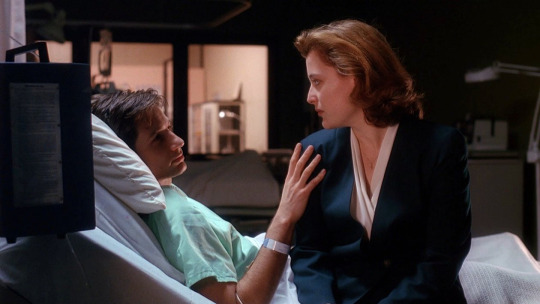
Darkness Falls (1x20)
Patient: Fox Mulder and Dana Scully
Reason: They took a nice trip to the forest and were almost devoured by insects.
*semantically speaking, this is a quarantine facility
Current Total Mulder: 2 Scully: 1
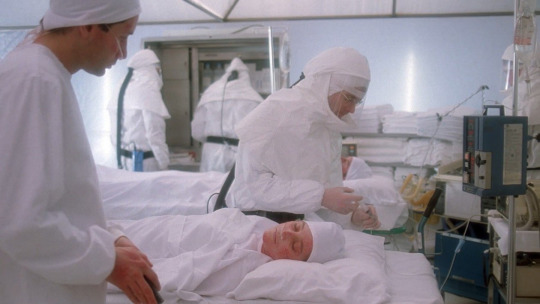
One Breath (2x08)
Patient: Dana Scully
Reason: She was ding dong ditched at the hospital by the people who had abducted her for months. The hospital was apparently so shocked, they forgot to give her a blanket :/
Current Total Mulder: 2 Scully: 2
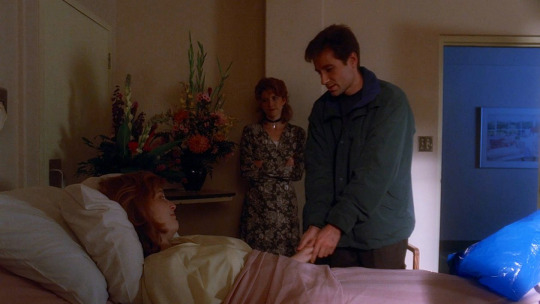
Colony (2x16) and End Game (2x17)
Patient: Fox Mulder
Reason: He was exposed to the Alien Bounty Hunter’s blood.
*counts as one since Colony begins in medias res with events from End Game.
Current Total Mulder: 3 Scully: 2

Død Kalm (2x19)
Patient: Fox Mulder and Dana Scully
Reason: They were on a ship where “contaminated water caused rapid oxidative damage and dramatically increased sodium chloride in the body,” (Scully, 1995).
Current Total Mulder: 4 Scully: 3
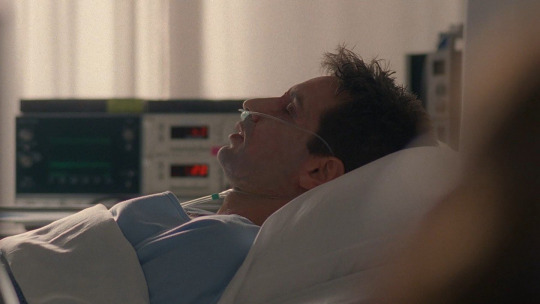

Apocrypha (3x16)
Patient: Fox Mulder
Reason: Mulder’s car is run off the road.
Current Total Mulder: 5 Scully: 3

Wetwired (3x23)
Patient: Dana Scully
Reason: Scully becomes victim to the control of a device that incites paranoid delusions.
Current Total Mulder: 5 Scully: 4

Memento Mori (4x14)
Patient: Dana Scully
Reason: She’s diagnosed with terminal brain cancer.
Current Total Mulder: 5 Scully: 5
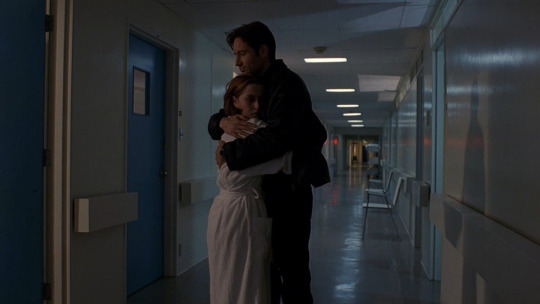
Redux II (5x02)
Patient: Dana Scully
Reason: Her terminal cancer flares up, but she is cured. Hopefully alien implants are part of her health insurance plan.
Current Total Mulder: 5 Scully: 6
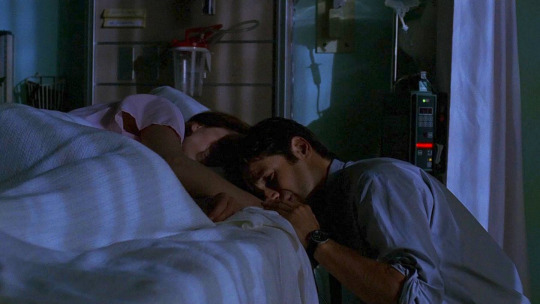
The Red and The Black (5x13)
Patient: Dana Scully
Reason: She sustained burns and smoke inhalation.
Current Total Mulder: 5 Scully: 7

Folie à Deux (5x19)
Patient: Fox Mulder
Reason: Mulder began seeing things others couldn’t (according to Scully, he was succumbing to folie à deux — shared psychosis), and Skinner had him committed.
Current Total Mulder: 6 Scully: 7

Fight the Future (1998)
Patient: Fox Mulder
Reason: He is shot by the people who abduct Scully.
Current Total Mulder: 7 Scully: 7

Triangle (6x03)
Patient: Fox Mulder
Reason: While searching for the Queen Anne, he wrecked his ship.
Current Total Mulder: 8 Scully: 7

Tithonus (6x10)
Patient: Dana Scully
Reason: Scully was accidentally shot by a fellow agent during a case.
Current Total Mulder: 8 Scully: 8

Biogenesis (6x22) and The Sixth Extinction (7x01)
Patient: Fox Mulder
Reason: He’s hospitalized for being in critical condition due to his abnormal brain activity.
*counts as one since he was never relocated/discharged in between episodes.
Current Total Mulder: 9 Scully: 8
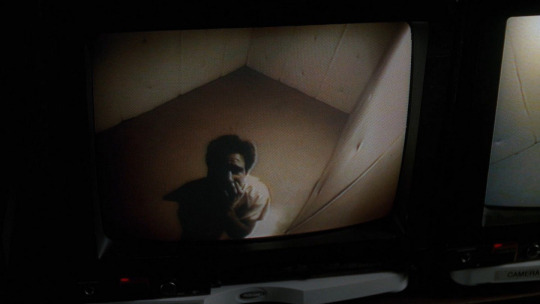
The Sixth Extinction (7x01) and The Sixth Extinction II: Amor Fati (7x02)
Patient: Fox Mulder
Reason: Abnormal Brain Activity (cont.)
*counts as a new one since he was relocated by Skinner and remains there in between these two episodes
Current Total Mulder: 10 Scully: 8

Signs and Wonders (7x09)
Patient: Fox Mulder
Reason: Attacked by snakes
Current Total Mulder: 11 Scully: 8
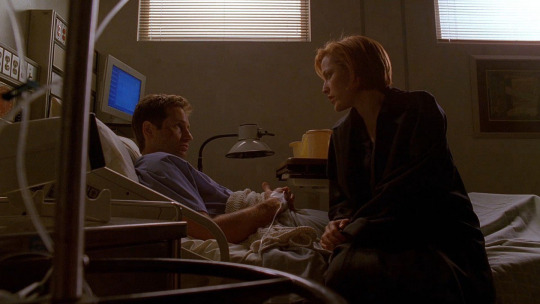
Brand X (7x18)
Patient: Fox Mulder
Reason: Beetle eggs began hatching in his lungs.
Current Total Mulder: 12 Scully: 8

Requiem (7x22)
Patient: Dana Scully
Reason: Scully faints at the office after realizing Mulder was in danger. It is later revealed she’s pregnant.
Current Total Mulder: 12 Scully: 9
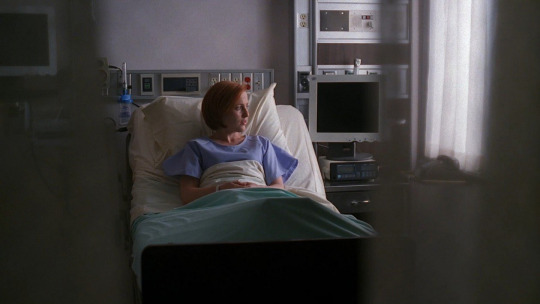
Without (8x02)
Patient: Dana Scully
Reason: She’s in a physical altercation with the Alien Bounty Hunter which leaves her with several injuries.
Current Total Mulder: 12 Scully: 10

Via Negativa (8x07)
Patient: Dana Scully
Reason: She checked herself into the hospital after feeling acute abdominal pain.
Current Total Mulder: 12 Scully: 11
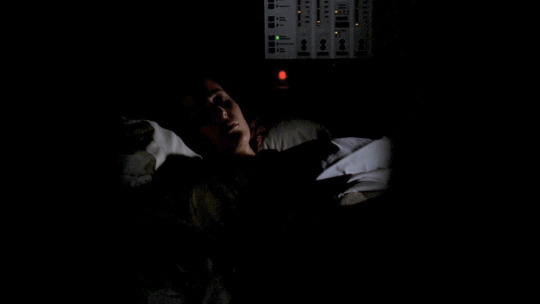
DeadAlive (8x14) and Three Words (8x15)
Patient: Fox Mulder
Reason: “Brought back from the dead.”
*counts as one since it is the same hospital stay between episodes
Current Total Mulder: 13 Scully: 11

Empedocles (8x17)
Patient: Dana Scully
Reason: She had some abdominal pain that turned out to be a partial abruption.
Current Total Mulder: 13 Scully: 12

Babylon (10x05)
Patient: Fox Mulder
Reason: He woke up in the hospital after apparently embarrassing himself while under the influence of placebos he believed were magic mushrooms.
Current Total Mulder: 14 Scully: 12
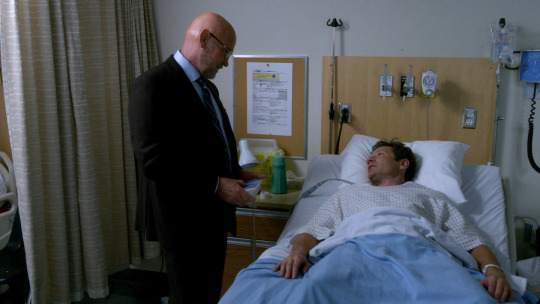
My Struggle III (11x01)
Patient: Dana Scully
Reason(s): She suffered from a seizure in the office; then another while driving and she crashed.
*this counts as two because she left the hospital and was brought back a second time.
Current Total Mulder: 14 Scully: 14


So how many times did we see Mulder and Scully admitted to the hospital?
Overall Total 🏥 Mulder: 14 Scully: 14
It’s a tie! 🥳
I stated earlier that this is not every time they were injured and not every time they went to the hospital. Instead, it is every time we saw them while they were admitted to the hospital as a patient.
As with everything, this can be calculated in different ways.
There were instances where we saw them go to the hospital for something temporary (Blood, Gesthemane) and there are episodes where they definitely went to hospital, but we didn’t see them (Zero Sum, Never Again).
This also doesn’t take into account variables like length of hospital stay or injury v. illness. It’s impossible to know the full circumstances in some cases and overall to estimate who spent the most *time* in the hospital.
All to say, this was just for fun and I acknowledge it is not comprehensive based on different criteria (so don’t come for me), but I do believe it is every time we see them on screen admitted in hospital gowns.
107 notes
·
View notes
Text
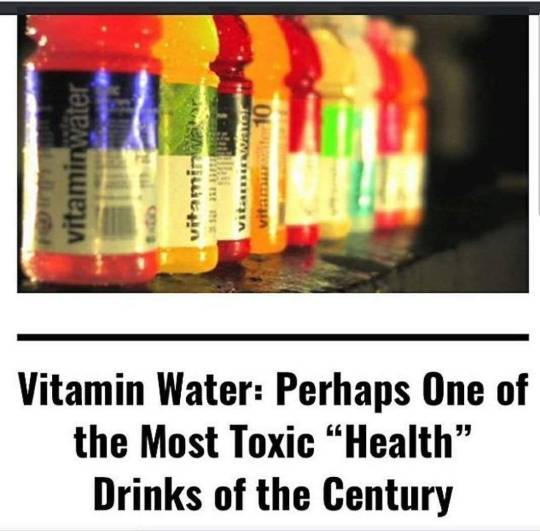
Coca-Cola’s VitaminWater is being marketed as a healthy, hydrating drink. The company claims that the drinks prevent chronic diseases, reduce the risks of eye diseases, promotes healthy joints, and supports optimal immune function. However, nothing could be further from the truth.
This is what John Robbins, Esq., PhD., M.D. says in his Mat Hoffman Post article:
The product is basically sugar-water, to which about a penny’s worth of synthetic vitamins have been added. And the amount of sugar is not trivial. A bottle of vitaminwater contains 33 grams of sugar, making it more akin to a soft drink than to a healthy beverage.
The ingredients of “orange-orange”-flavored vitaminwater:
Reverse osmosis water, crystalline fructose, cane sugar, less than 0.5% of: citric acid, magnesiumlactate and calcium lactate and potassium phosphate (electrolyte sources), natural flavors, vitamin C (ascorbic acid), gum acacia, vitamin B3 (niacinamide), vitamin E (alpha-tocopheryl acetate), vitamin B5 (calcium pantothenate), glycerol ester of rosin, vitamin B6 (pyridoxine hydrochloride), vitamin B12, beta-carotene, modified food starch, sorbitol.
VitaminWater’s sugar levels are very very high. One 500ml bottle contains 27 grams of sugar, that’s about 8 teaspoons of sugar!
Crystalline Fructose
Crystalline fructose is produced by allowing the fructose to crystallize from a fructose-enriched corn syrup. So basically, it is made from corn syrup, and not only corn syrup, but “fructose enriched” corn syrup. Crystalline Fructose contains 99.5% minimum of fructose assay, which is a greater higher percentage of fructose than what makes up high fructose corn syrup. Crystalline fructose may be contaminated with arsenic, lead, chloride and heavy metals. This type of fructose leads to increased belly fat, insulin resistance, and metabolic syndrome. Large amount of fructose can create a fatty liver and cirrhosis as it can not be processed completely in the liver. The fructose interferes and alters the metabolic process in our cells, which causes oxidative damage.
14 notes
·
View notes
Text
I know that this account was suppose to turn into a shitpost headcannon account but y'all I fucking love chemistry so much I can't even
Like sometimes I wish that there were fics of MC in obey me verse just doing chemistry with Solomon
For one I'm down bad
And for 2 I LOVE CHEMISTRY 🥺
Like my fucking chem final is in a few hours and we get to make one paper of a cheet sheet
so I fucking crammed last night and did all of the imporntatnt chapter shit from my notes and the textbook
Back to om for a sec tho I'd totally write a fic abt MC just loving chem as much as I do but like idk the chem in devildom is dif for some reason so they have to relearn shit but also teach people human chem
Like bro I love chem sm 😭😭
I already have some ideas about what could be dif between the two realms;
The periodic table could be different because of exposure to different substances and elements, which in turn makes the organisation different
Like the transition metals are larger, the man-made elements don't exist, the F block is way smaller/larger because of the exposure to different substances,
Exposure to elements are higher - for example, exposure and access to elements like Argon and ones w higher atomic masses and such are easier to find and use in experiments
The safety protocols are WAY dif, like in chem classes they don't even have the fuckin lab safety thing doesn't exist (because they're fucking demons) so things are a lot more reckless
Labs tend to be -- bigger? Like more combustion and danger involved, rather than labs that'd be seen in high school chem classes (mixing Calcium Chloride and Magnesium Sulfate for example)
Yeah man idfk I just love chem
---
Ooh here are some little snippets 😍
Solomon and MC get paired together in a chem class with not very many instructions, only being told to make an explosion with the least amount of substances. So what do they do? Pour Lithium into water
At some point after MC decides to really live-in their room in the HoL (cause like really they're sleeping in the fucking hotel guest room) they receive some chemistry equipment from Solomon. One night they don't come down for dinner and one of the bros (you choose who) comes to see what's up and they just find MC hunched over their desk trying to organise substances without cross contaminating anything, which is very hard when most things come looking like cocaine
Alternatively, it's the middle of the day and they're doing some experiment involving having to force copper to oxidize, and somehow they make the air in their room extremely explosive (think that one scene in The Martian book) After realising this, they leave their room and sit outside their door while trying to air out their room. (Fan on high, windows open all the way, door open, etc) They get questioned, yadda yadda yadda, they get banned from doing experiments in the house
Fun one; they make elephant toothpaste for Luke after he asked about what they do
Super fun one; they pull a Nile Red and do some crazy shit like make paint thinner into soda and have one (or more) of the characters drink it and half way through them drinking it MC just goes "it's actually paint thinner"
MC correcting the shit out of a teacher in RAD and somehow ending up teaching the class. Then there's a video found online of MC teaching the class and they become the resident chemistry nerd and get paid to do other people's work (before Lucy shuts it down 🙄)
Yeah uh
I don't know man I wrote like half of this at like 7 in the morning before my chem final and my brain is still on chem
I'm on break now so I can do whatever I want now but yk
---
Oh yeah here are some clarification things for those who have no clue abt terminology 😭
Transition metals are the columns in the periodic table between column 2 and 13, it's the metals like silver, gold, copper, tungsten, etc
The F block is the elements shoved underneath the rest of the table that realistically start in column 2
More for curious people; mixing CaCl2 and MgS gives you a precipitate (solid) and liquid - more specifically MgCl2 and CaS (this is without balancing them)
Lithium explodes in water - don't listen to google when it says to wash it off your hands with water
Oxidizing copper will basically change its color and make it rust
You make elephant toothpaste by mixing dry yeast, warm water, dish soap, and 3% hydrogen peroxide
wooo ok
Yeah that's it idk I love chemistry it's so fun
<3333
aight
If anyone's interested in my chem cram sheet lmkkk <33333
drink your dihydrogen monoxide <3
Edit;
Here's my cram sheets for those who want it


#dude I love chemistry#chemistry#rant post#kind of#anyway#obey me crack#obey me solomon#obey me shall we date#obey me#obey me luke#obey me shitpost
38 notes
·
View notes
Text
Let's investigate the 4 chemicals in Palestine Ohio's train derailment and their so-called slow burn operation that our government said was safe.👇
1. VINYL CHLORIDE
A chemical warfare agent in WWII ☠️
Is vinyl chloride harmful to human health?
⚠️Exposure to vinyl chloride may increase a person's risk of developing cancer. Human and animal studies show higher rates of liver, lung and several other types of cancer. Being exposed to vinyl chloride can affect a person's liver, kidney, lung, spleen, nervous system and blood.
How much vinyl chloride cause cancer?
Studies of long-term exposure in animals showed that cancer of the liver and mammary gland may increase at very low levels of vinyl chloride in the air (50 ppm). Lab animals fed low levels of vinyl chloride each day (2 mg/kg/day) during their lifetime had an increased risk of getting liver cancer.
Is vinyl chloride a hazardous waste?
⚠️Vinyl Chloride is hazardous to the environment.
2. ETHYLENE GLYCOL
What is ethylene glycol used in?
DESCRIPTION: Ethylene glycol is a useful industrial compound found in many consumer products. Examples include antifreeze, hydraulic brake fluids, some stamp pad inks, ballpoint pens, solvents, paints, plastics, films, and cosmetics.
How is ethylene glycol harmful to humans?
An overdose of ethylene glycol can damage the brain, lungs, liver, and kidneys. The poisoning causes disturbances in the body's chemistry, including metabolic acidosis (increased acids in the bloodstream and tissues). The disturbances may be severe enough to cause profound shock, organ failure, and death.
How does ethylene glycol affect the brain?
Ethylene glycol (EG) is a toxic alcohol that causes central nervous system depression and multiple metabolic abnormalities including a high anion gap metabolic acidosis (HAGMA), elevated osmolal gap (OG), and acute kidney injury. Few case reports of EG intoxication report brain MRI findings.
Is ethylene glycol a carcinogen?
🚩EPA has not classified ethylene glycol for carcinogenicity. Chronic Effects (Noncancer): The only effects were noted in a study of individuals exposed to low levels of ethylene glycol by inhalation for about a month were throat and upper respiratory tract irritation.
Is ethylene glycol monobutyl ether harmful to humans?
The substance is irritating to the eyes, skin and respiratory tract. The substance may cause effects on the central nervous system, blood, kidneys and liver. A harmful contamination of the air will be reached rather slowly on evaporation of this substance at 20°C.
3. MONOBUTYL ETHER
What is the use of monobutyl ether?
It is used as a solvent in surface coatings in paints; as a coupling agent in metal and household cleaners; as an intermediate in chemical production; and is also found in brake fluids and in printing ink.
Is butyl ether toxic?
⚠️Acute Health Effects☠️
The following acute (short-term) health effects may occur immediately or shortly after exposure to Butyl Ether: * Contact can irritate the skin and eyes. * Repeated or prolonged skin contact may cause rash. Breathing Butyl Ether can irritate the nose and throat causing coughing and wheezing.
Is ether toxic to humans?
⚠️Breathing Diethyl Ether can cause drowsiness, excitement, dizziness, vomiting, irregular breathing, and increased saliva. High exposure can cause unconsciousness and even death.
Is ether a carcinogen?
► Bis(Chloromethyl) Ether is a CARCINOGEN in humans. There may be NO safe level of exposure to a carcinogen, so all contact should be reduced to the lowest possible level.
Combustible. Above 60°C explosive vapour/air mixtures may be formed. NO open flames. Above 60°C use a closed system and ventilation.
4. ETHYLHEXYL ACRYLATE
Is ethylhexyl acrylate toxic?
Like any reactive chemical, 2-Ethylhexyl acrylate can be hazardous if not handled properly. May be harmful if swallowed. Ingestion may cause gastrointestinal irritation or ulceration. Limited dermal contact or vapour concentrations attainable at room temperature are not hazardous on single short duration exposures.
Is Ethylhexyl acrylate copolymer safe?
Although the monomers may be toxic, the levels that would be found in cosmetic formulations are not considered to present a safety risk. Accordingly, these Acrylate Copolymers are considered safe for use in cosmetic formulations when formulated to avoid irritation.
Are acrylates safe?
The International Agency of Research on Cancer as well as the U.S. Environmental Protection Agency (EPA) have classified acrylates as a possible human carcinogen. Exposure to acrylates has been linked to skin, eye, and throat reactions [1] as well as more serious health consequences such as: Cancer.
Is ethylhexyl harmful for skin?
Ethylhexylglycerin is not safe due to its performance as a contact allergen.
Is ethyl acrylate carcinogenic?
⚠️Cancer Hazard☠️
* Ethyl Acrylate may be a CARCINOGEN in humans since it has been shown to cause stomach cancer in animals.
🚩Spoiler Alert⚠️ It's NOT safe and in fact it is highly toxic☠️
This will affect millions of people and it may flow into the Mississippi river as well. 🤔
#pay attention#educate yourself#educate yourselves#reeducate yourself#knowledge is power#reeducate yourselves#think for yourself#think for yourselves#think about it#do your homework#do your research#do your own research#question everything#ask yourself questions#ask yourself#toxic chemicals#train derailment#palestine ohio#catastrophe
153 notes
·
View notes
Text
As Salt Water Flows up the Mississippi River for a Third Year, the Region Looks for Permanent Solutions. (Sierra Club)
Excerpt from this story from the Sierra Club:
Just off the Mississippi River in southeast Louisiana, an 18-wheeler trailer filled with white cylinders whirred as workers prepared to turn the machine off for the day. The truck houses a reverse osmosis system, and it’s stopping salt water from contaminating drinking water for more than 20,000 people.
This is the third year in a row that salt water from the Gulf of Mexico has crept up the Mississippi River. This phenomenon, known as saltwater intrusion, occurs when the rate of flow in the river dips below 300,000 cubic feet per second, leaving the river’s fresh water unable to push back against salt water at its mouth. Previously, this only happened about once per decade.
For cities within 100 miles of the river’s southern terminus—most of whom depend on the river’s fresh water for their drinking water—saltwater intrusion is an existential threat. Last year, the saltwater wedge almost reached as far as New Orleans, 80 miles upriver, causing panic until rains pushed it downriver.
But it did reach Plaquemines Parish, which surrounds the last 70 miles of the Mississippi.
“When you go across the ferry and you look out at the water, when it's blue-green-type water, I can guarantee you Boothville and the lower end of our parish is salt water,” said Keith Hinkley, the president of Plaquemines Parish.
In 2023, the presence of salt water that far up the river affected the drinking water for months, forcing residents to buy bottled water and replace appliances damaged by the salinity. Even after the water became safe, residents were still afraid to drink from their tap. Consuming salt water can cause dehydration. The chloride could have also damaged outdated pipes, releasing lead and other contaminants into the water.
For now, the effective solutions are the water treatment upgrades and the salt water sill—a temporary underwater structure, made of material dredged from a sandbar in the river, that’s currently blocking the saltwater wedge from moving much farther. “Without the sill, the wedge would travel maybe at least 20 miles, if not more, upriver,” said Ehab Meselhe, a professor of River-Coastal Science at Tulane University. It wasn’t until this week that the wedge began to retreat downstream from the sill since it started moving upstream in September.
5 notes
·
View notes
Text
A few days after the release was discovered in June 2017, Stan met with Southcreek and the Oklahoma Corporation Commission, the state’s oil and gas regulatory agency. At the meeting, the company characterized the incident as a “small spill,” the Ledgerwoods later alleged in court. It was unclear how long the leak lasted, but the saltwater plume had already saturated the soil and killed 2 acres of vegetation by the time it broke the surface, according to state oil regulators. Samples analyzed a month later by Oklahoma State University found that the soil’s concentration of chloride, which occurs in the type of salt water injected into the well, had risen to more than 12 times the state’s acceptable level and was “sufficiently high to reduce yield of even salt tolerant crops.” Other tests showed that chloride levels in the family’s water well had spiked to more than five times what the Environmental Protection Agency deems safe. The tests didn’t look for other contaminants like heavy metals that are often left behind by the oil production process. - - Don began traveling 30 miles round-trip to Walmart to buy bottled water. Stan and Tina’s steel pots rusted after being washed, and their 2-year-old great-niece’s skin became irritated and inflamed after repeatedly washing her hands while they potty-trained her. In a text message, the girl’s mother described her hands as looking like they had “a burn.” - - As is common in American oil fields, property rights in this part of Oklahoma often create split estates, where one person owns the land while another owns the underlying minerals, such as oil and gas. The owner of the minerals has a right to drill, even if the landowner would prefer they didn’t. - - But Oklahoma has more than 260,000 unplugged wells — behind only Texas — according to data from energy industry software firm Enverus. To plug and clean up the state’s wells could cost approximately $7.3 billion, according to an analysis of state records. Oklahoma has just $45 million in bonds. The oil industry’s bonds are “shockingly inadequate,” said Peter Morgan, a Sierra Club senior attorney. “It’s clear that abandoning wells and leaving communities and taxpayers to foot the bill to clean them up is baked into the oil and gas industry business model.” At the Capitol in Oklahoma City, which features repurposed oil derricks outside its main entrance, Republican state Rep. Brad Boles has tried for several years to address the shortfall. This year, he introduced a bill to create a tiered bonding system based on the number of wells a company operates, increasing the highest required bond to $150,000. [passed House, did not gt a vote in Senate] - - A stream of trucks rumbled down the Ledgerwoods’ once-quiet gravel road as workers removed enough dirt to fill 750 dump trucks and pumped more than 71,000 gallons from the Ledgerwoods’ water well. But the dangerous concentrations of chloride didn’t change, according to Fox Hollow’s report. - - Progress in the lawsuit was short-lived. In November 2019, shortly after the Ledgerwoods’ attorney sent discovery requests to Wise Oil & Gas, the company filed in a Texas court for voluntary Chapter 7 bankruptcy — a full liquidation of its assets. Company executives acknowledged they declared bankruptcy to avoid legal fees associated with the Ledgerwoods’ suit, according to court records. - - But two months later, Mullin ruled against the Ledgerwoods. He disagreed that Wise Oil & Gas had entered bankruptcy to shed bad investments and dodge cleanup obligations. He blasted the Ledgerwoods for requesting sanctions against the Cocanoughers. “Merely because the Ledgerwood Creditors have been damaged by the saltwater contamination, this does not provide them with an unfettered right to retaliate or lash out against unrelated and far-removed targets, such as the Cocanougher Sanction Targets,” Mullin wrote. If the Ledgerwoods wanted to continue seeking damages against the Cocanoughers and their businesses, they would have to pay the oil company’s attorneys’ fees, about $107,000, Mullin ruled.
It's worth reading the whole article for a breakdown of exactly HOW a company that poisoned a family's well and farm got out of fixing it or paying compensation.
Not as relevant in this particular case, but uncapped out of service wells like this are a major source of methane, an even more potent greenhouse gas than CO2
9 notes
·
View notes
Text

Bronze disease is an irreversible and nearly inexorable corrosion process that occurs when chlorides come into contact with bronze or other copper-bearing alloys.[1] It can occur as both a dark green coating, or as a much lighter whitish fuzzy or furry green coating.[1] It is not a bacterial infection, but the result of a chemical reaction with the chlorides that usually occurs due to contamination of the bronze object by saltwater or from burial in specific types of soil where chloride salts are present.[1] If not treated, complete destruction of the affected artifact is possible.[1] Treatment is very difficult, costly and not always effective. Transfer of chlorides from the contaminated artefact to other artefacts can spread the condition.[2][3][4]
43 notes
·
View notes
Text
This has been brushed under the table by Wall Street (who own Norfolk Southern) and the Ohio/Pennsylvania govts, but reporting on it because it's a disaster: As a result of rail corruption/mismanagement (and USgov thanos snapping the rail strikes), a Norfolk Southern chemical freight train was derailed and spilled its load on Feb 3 near East Palestine (a town on the very eastern side of Ohio), which then apparently exploded. [Apparently. Lots of claims going around, but I can't find a source.] They decided to burn the vinyl chloride to stop it from leeching into the environment further, because letting it leech into the air was better I guess. This is relevant for anyone living in Ohio, Pennsylvania, West Virginia, and potentially Western New York. The chemicals reported to be carried were Vinyl Chloride [carcinogen with a boiling point of 8F/-13C that releases dangerous gases into the atmosphere], Ethylene Glycol Monobutyl Ether, Ethylhexyl Acrylate [carcinogen], and Isobutylene. The train was 50 cars long.
Immediate effects have shown up in East Ohio and West PA, including reports of "acrid smells", as well as smoke clouds and fish, birds, and foxes turning up dead. Contaminants are confirmed to have reached the Ohio River and have leeched into the water supply of vulnerable towns in West Virginia. Local water sources and well water should be avoided and treated with scrutiny, as far as Eastern/southern Ohio, Northern WV, and Western PA. It is unclear what other water supplies have been contaminated, but veering on the side of caution for now is better - tests are still being taken and the situation is developing.
As a result of the burn, Phosgene gas and Hydrogen Chloride are spreading into the atmosphere. Hydrogen Chloride, now pumped into the air as a result of the burn, bonds with water vapor and turns into Hydrochloric Acid. This may cause acid rain. The wind is blowing west to northeast and affects Eastern Ohio, Pennsylvania and potentially, should it reach far enough, parts of Western NY (though it's unclear how far this is going to spread). This will affect people and animals over the long term on a scale comparable to 9/11 and some of the worst oil spills, and was entirely preventable had rail companies not cut corners on the operation and safety of their trains and train routes. Additionally, two more trains with hazardous material have derailed in South Carolina and Texas, though no known burns have occurred from those yet.
74 notes
·
View notes
Text
The aftermath of last year's fiery train derailment in eastern Ohio doesn't qualify as a public health emergency because widespread health problems and ongoing chemical exposures haven't been documented, federal officials said.
The Environmental Protection Agency never approved that designation after the February 2023 Norfolk Southern derailment even though the disaster forced the evacuation of half the town of East Palestine and generated many fears about potential long-term health consequences of the chemicals that spilled and burned. The contamination concerns were exacerbated by the decision to blow open five tank cars filled with vinyl chloride and burn that toxic chemical three days after the derailment.
The topic of a public health emergency came up in emails obtained by the Government Accountability Project watchdog group through a public records request. But EPA Response Coordinator Mark Durno said the label, which the agency has only used once before in Libby, Montana — where hundreds of people died and thousands were sickened from widespread asbestos exposure — doesn't fit East Palestine even though some residents still complain about respiratory problems and unexplained rashes. Officials also believed the agency had enough authority to respond to the derailment without declaring an emergency.
Durno said the reason a public health emergency isn’t being considered is that “we have not had any environmental data” about ongoing chemical exposures in the extensive air, water and soil testing program.
The EPA said in a statement that the order it did issue telling Norfolk Southern it was responsible for the damage declared that "the conditions at the derailment site ‘may constitute an imminent and substantial endangerment to the public health or welfare or the environment.’” So the agency said it didn't see a need for a public health emergency because it had the legal authority it needed to respond.
But area residents like Jami Wallace see plenty of evidence that their hometown has become a disaster every time they open Facebook and see posts about their friends' kids covered with rashes or struggling with chronic nosebleeds. Other posts talk about the smell of chemicals returning after heavy rains.
“They keep saying it’s a coincidence, but if this was your family, wouldn’t you get tired of it being a coincidence?” Wallace said.
Lesley Pacey, who is an environmental investigator with the watchdog group, said she wants to make sure that East Palestine residents get the help that they need to recover from the derailment.
“I talk to residents all the time and they’re having new seizures pop up, cancers. I mean, a lot of the damage has already been done to these people,” Pacey said.
Federal and state officials continue monitoring for additional problems in the small community near the Pennsylvania border, according to Durno. The EPA also keeps testing the air and water in the area as it oversees the railroad's work to clean up the mess.
He reiterated that none of the agency's more than 100 million tests of air, water and soil ever showed concerning levels of chemicals apart from the soil immediately around the derailment that was dug up and disposed of last year.
In the recently disclosed emails, an EPA lawyer tells one of its PR people it was “best not to get into this” when he was asked whether a document explaining the agency's order telling Norfolk Southern to clean up the contamination from the derailment should include anything about medical benefits. That kind of aid, which could include Medicare coverage, is only available if EPA declares a public health emergency.
“But again there was no data suggesting that that was necessary. And to this date, there is no data that suggests that that’s necessary,” Durno said
The railroad has already spent more than $1.1 billion on its response to the derailment, including more than $104 million in direct aid to East Palestine and its residents. Partly because Norfolk Southern is paying for the cleanup, President Joe Biden has never declared a disaster in East Palestine, which is a sore point for many residents. The railroad has promised to create a fund to help pay for the long-term health needs of the community, but that hasn't happened yet.
The emails also provide a reminder that the EPA was aware of the potential dangers of releasing and burning the vinyl chloride. But that was already made clear when the EPA advised officials on scene that phosgene — which was used as a chemical weapon in World War I — and hydrogen chloride would likely be created when vinyl chloride is burned and warned the public about that possibility.
The officials who made the decision to release the vinyl chloride — Ohio's governor and the local fire chief leading the response — decided that releasing and burning it was safer than risking a tank car or more exploding.
Ultimately, Durno said the EPA found only low levels of hydrogen chloride in the plume of thick black smoke and no phosgene. And he said the agency took extensive samples throughout the area to monitor for those chemicals during the burn and evacuation even though weather conditions kept its specialized plane with additional testing equipment grounded on the day of the burn.
The head of the National Transportation Safety Board said recently that her agency's investigation showed that the vent and burn of the vinyl chloride was unnecessary because the company that produced that chemical was sure no dangerous chemical reaction was happening inside the tank cars. But the officials who made the decision have said they were never told that.
The NTSB's full investigation into the cause of the derailment won't be complete until June, though that agency has said that an overheating wheel bearing on one of the railcars that wasn't detected in time by a trackside sensor likely caused the crash.
The EPA has said the cleanup in East Palestine is expected to be complete sometime later this year.
Rick Tsai, a chiropractor who ran in the March primary for the U.S. congressional seat on the derailment, sees a dismal future for the small township the longer that it goes without the resources it needs to make it safe again — resources the public health emergency designation could help provide.
“People are just about to give up,” he lamented. “I don’t think people have much hope anymore.”
5 notes
·
View notes